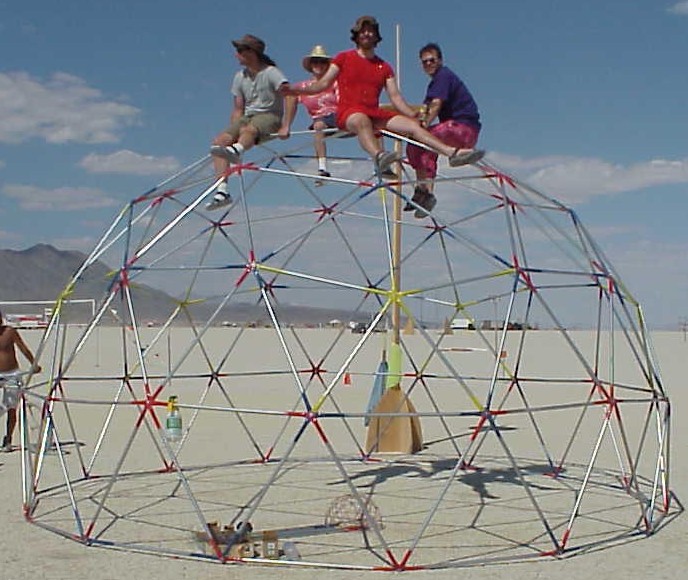How to Build A Geodesic Dome
Support this site-
How to Build a 16 foot Geodesic Dome
-
How to Build a 24 foot Geodesic Dome
-
How to Cover a Geodesic Dome

Strength of a dome
This picture is of a 3 frequency dome, roughly 16 feet in diameter, with four adults sitting on top of it. It is made of 3/4 inch awning tubing (which is stronger than 3/4 inch conduit). Because each pole is so short, it is safe to climb on. This is a graphic demonstration of the strength of a geodesic dome. If a dome has significantly longer poles, it is not recommended for climbing, unless the poles are larger in diameter. I have seen someone climb my 24 foot dome which has 3/4 inch conduit poles roughly 5 feet long, but they had to be careful to only stand on the intersections (as well as being very limber).
Securing a dome
I think a 3/8 sphere dome is stable on the ground when windy, due to its low profile. A 1/2 sphere or 5/8 sphere dome is not, and needs to be secured to the ground so it doesn't blow away. The simplest way to secure a dome to the ground is to drive in rebar stakes around the perimeter of the dome. I recommend doing this near the intersection of the dome poles, where the dome is the strongest. I also recommend driving the stake from the outside of the dome, so that it fits snugly next to the inside of the poles. If you do that all around the dome, it will be very stable in high winds. I used 10 stakes to secure my 24 foot dome.
I pre-bent some 3/8 inch rebar for tent stakes. It was a mistake. 3/8 inch rebar is plenty strong, but very flexible. 1/2 inch rebar works better. I liked 3 foot long straight rebar, as it is very easy to hammer with a sledgehammer. Perhaps rebar bent into a U shape would work, pounding on the center of the U. Rebar bent into a J shape doesn't stay that way after pounding on the bottom of the J.
You can buy tough plastic mushroom looking ends for rebar. I got a bunch used at a construction site for free. Seems like the best bet. They are bright orange. You can also find them at Home Depot or places that sell rebar. You can see them in the 2001 pictures. Be sure to have some kind of cover for the rebar ends, and they can make serious wounds.
Also visible are some of the rebar stakes I used to secure the dome. I used 5/8 rebar, not for strength, but for ease of hammering. I bought 10 foot sections, and cut them in thirds. For 1/2 inch, I used some big bolt cutters, but they didn't work well on the 5/8 rebar. I used a silicon-carbide blade in my reciprocating saw, as a hacksaw took too long. To remove the rebar, a friend came up with a clever solution. He first hit the rebar sideways with a sledgehammer to loosen things up a bit. Next, he attached two vice-grip pliers, at the top of the rebar on opposite sides. He used the two vice-grips to rotate the rebar. Next, he lifted as he rotated the rebar. It worked pretty well.
To pound in rebar stakes, get some iron sprinkler pipe big enough to fit over the rebar, and an end cap for the sprinkler pipe. Six inches of pipe will do. Put the pipe and end over the rebar before pounding. This will keep the end of the rebar from mushrooming, and it is much easier to hit than the bare rebar. After a while, the end cap will break. Bring a few spares.
To remove the rebar, the easy way is to use a stakepuller This tool is very simple and quick to use to remove rebar stakes. It can bend the rebar a bit, but it is so quick and easy, it isn't funny. Get the 'small stakepuller'. It is a bit spendy, but worth it.
Recently, I came across some 'Pet Stakes'. These are made of steel rod and are shaped to screw into the earth. There is a flat triangular handle (like a sprinkler valve tool) to help with the scewing and unscrewing. Harbor Freight sells 18 inch long pet stakes for $2, and they have a ring (to attach a leash). I wonder how well they would secure a dome. If they worked, they wouldn't require a hammer to drive them in, and they would be easy to remove. There would be no need to cover the end to prevent injury either. I think they might work quite well for smaller domes. Worth a try.